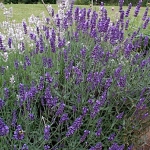
Known for its calming, heavenly scent, English Lavender is also and excellent antibacterial that, in oil form, has been used to kill heavyweight bacteria such as streptococcus, pneumonococcus, diphtheria, and typhoid. Applied topically, English Lavender is also a remedy for cuts, burns, and stings; when inhaled with steam, it eases coughs, colds, and chest infections.
Small Shrub with downy, linear leaves, to 6cm (2½in) long which are gray when young. Blue violet flowers grow in compact or interrupted spikes, to 8cm (3in) long.
|
|||||||||||||||||||||||||||||||||||||||||||||||||||||||||||||||||||||||||||||||||||||||||||||||||||||||||||||||||||||||||||||||||||||
European folk herbalists believed that lavender acted as an anaphrodisiac, that is, it quelled sexual passion, and they recommended the crushed flowers be sprinkled on one’s head to maintain purity. Early American colonists, among them may English Puritans, made a paste of fresh lavender flowers combined with vinegar and spread it on their foreheads to relieve persistent headaches. And the seventeenth-century herbalist Nicholas Culpeper recommended a tea made of lavender, horehound, fennel, asparagus, and cinnamon to treat “giddiness or turning of the brain”. |
|||||||||||||||||||||||||||||||||||||||||||||||||||||||||||||||||||||||||||||||||||||||||||||||||||||||||||||||||||||||||||||||||||||
An aromatic, tonic herb with a sweet scent. It relaxes spasms, benefits the digestion, stimulates peripheral circulation and uterus, and lowers fevers. It has anti-depressant effects and is antiseptic. |
|||||||||||||||||||||||||||||||||||||||||||||||||||||||||||||||||||||||||||||||||||||||||||||||||||||||||||||||||||||||||||||||||||||
|
|||||||||||||||||||||||||||||||||||||||||||||||||||||||||||||||||||||||||||||||||||||||||||||||||||||||||||||||||||||||||||||||||||||
To treat loss of appetite, insomnia, migraines, asthma, and rheumatic ailments. Germany’s Commission E has approved the use of English Lavender to treat insomnia, nervousness, loss of appetite, stomach complaints, and circulatory problems. Today lavender flowers are used internally—in teas and decoctions—for headache, depression, stress, insomnia, indigestion, gas, nausea, and colic. Strongly antiseptic and antibacterial, lavender oil is applied externally to treat burns, infections, eczema, acne, fungi, and ringworm. The oil also has pain-relieving and sedating qualities and is spread on the skin or inhaled to relieve head and sinus pain. An essential ingredient in many aromatherapy treatments, lavender is inhaled to increase mental acuity, stimulate creativity, and relieve depression. (For depression, lavender is often combined in teas with kola nut, rosemary, or skullcap (Scutellaria lateriflora). |
|||||||||||||||||||||||||||||||||||||||||||||||||||||||||||||||||||||||||||||||||||||||||||||||||||||||||||||||||||||||||||||||||||||
|
|
|||||||||||||||||||||||||||||||||||||||||||||||||||||||||||||||||||||||||||||||||||||||||||||||||||||||||||||||||||||||||||||||||||||
| URINARY | CIRCULATORY | RESPIRATORY |
| Lavender 6 | Lavender 7 | Lavender 6 |
| Sandalwood 4 | Ylang-Ylang 3 | Benzoin 4 |
| Juniper 2 | Melissa 2 | Cedarwood 2 |
|
|
||
| REPRODUCTIVE | NERVOUS | MUSCULAR |
| Lavender 6 | Lavender 7 | Lavender 7 |
| Sandalwood 4 | Frankincense 3 | Coriander 3 |
| Rose 3 | Rose 3 | Nutmeg 3 |
|
|
||
| SKELETAL | SKIN | EMOTION |
| Lavender 7 | Lavender 4 | Lavender 6 |
| Rosemary 4 | Chamomile (R) 2 | Neroli 3 |
| Chamomile (G) 3 | Sandalwood 2 | Petitgrain 2 |
Magical Aromatherapy by Scott Cunningham Copyright © 1989 Llewellyn Publications Inc. pp. 101-103
Wicca, Guide to the Solitary Practioner by Scott Cunningham Copyright © 1988 Llewellyn Publications, Inc. pp. 159-168
The Encyclopedia of Herbs by Deni Bown Copyright © 1995, 2001 Dorling Kindersley Limited pp.252-254
The Essential Herb-Drug-Vitamin Interaction Guide by Geo. T. Grossberg,MD and Barry Fox,PhD Copyright©2007 Barry Fox,PhD. Pp.197-200
The Modern Herbal Primer by Nancy Burke Copyright©2000 Yankee Publishing Inc. pp. 117-118


